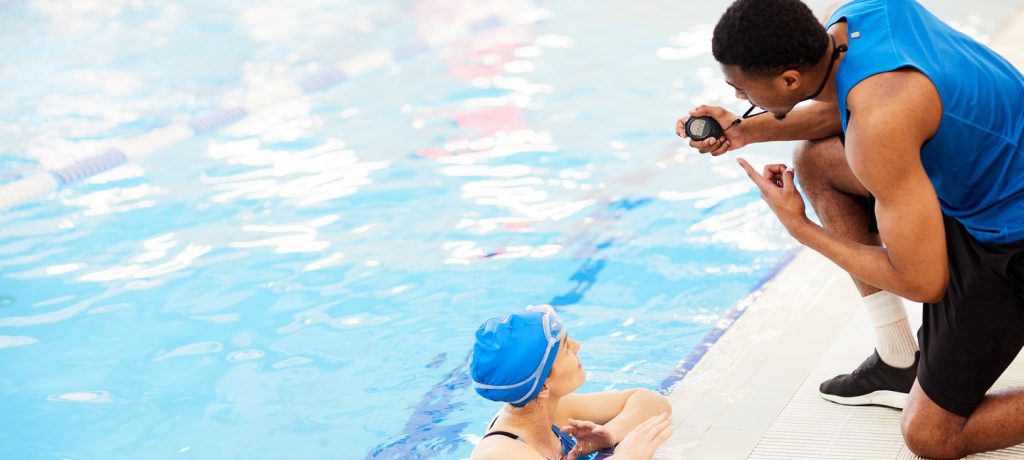Transitioning Personal Training from Land to Water
PowerCert

Authors: Aquatic Exercise Association (AEA), June Chewning BS MA Exercise Phys AEA
Description:
There is a growing demand for Aquatic Personal Trainers with expanding opportunities. Specialized training will allow you to enter the field with confidence, skill, and knowledge maximizing your potential for hire.
You can’t just do land exercise in the water- it is not effective! This certificate program consists of 4 eLearning courses to help you build a strong foundation for personal training in the water. Understanding the principles of the water, how water affects human movement, the effects of submersion on the body and cardiorespiratory system, and recommended movement and formats for aquatic exercise provides knowledge to enable you to build safe and effective programs to get client results!
Education Level: Intermediate to Advanced
Prerequisites: NAFC Personal Training Certification, or a College Degree in the Fitness Field, or an approved Equivalent.
Target Audience: Health-Fitness Professionals, Allied Health and Medical Professionals.
$174.95
Course Information
- Course 1: Introduction to Aquatic Personal Training Online Interactive Course (3 Hours)
- Course 1 Online Exam
- Course 2: Aquatic Personal Training Programming Online Interactive Course (4 Hours)
- Course 2 Online Exam
- Course 3: Applied Anatomy: Land and Water Online Interactive Course (4 Hours)
- Course 3 Online Exam
- Course 4: Determining Intensity with Aquatic Heart Rates Online Interactive Course (2 Hours)
- Course 4 Online Exam
Time to Complete: 18 Months to complete Examination Process
Course Access: Continued access with updates available
Course Objectives: Introduction to Aquatic Personal Training
After completing this course you will be able to:
- Know basic requirements for personal training in the aquatic environment.
- Discover opportunities for aquatic personal training.
- Understand the effects of water immersion on human anatomy and physiology.
- Be able to effectively train in the aquatic environment with proper knowledge of aquatic exercise environmental factors including water temperature, humidity and air temperature, water quality, air quality, pool considerations, and acoustical factors.
- Know basic dress for aquatic exercise and personal training.
- Understand basic properties of the water including viscosity, buoyancy, heat dissipation, hydrostatic pressure, and surface tension.
- Have a general knowledge of basic aquatic training formats including shallow water, deep water, transitional water, and mixed formats.
- Learn and review American College of Sports Medicine (ACSM) workout component guidelines with considerations and adaptations for the aquatic environment.
- See sample work outs for personal training in the aquatic environment.
- Learn recognition of a water crisis and basic assist/rescue skills for the aquatic environment.
Course Objectives: Aquatic Personal Training Programming
After completing this course you will be able to:
- Learn how to properly and effectively alter intensity in the aquatic environment.
- Discover theories why aquatic heart rates are lower in the water than comparable exercise on land.
- Learn how to properly calculate an aquatic target heart rate or zone and properly monitor intensity for cardiorespiratory exercise.
- Explore ways to monitor intensity for resistance training in the aquatic environment.
- Understand impact level and speed variation for aquatic exercise.
- View base movements for shallow water exercise.
- Be able to plan basic, intermediate, and advanced transitions for your exercise sequences.
- Discover formats that work well for shallow water exercise.
- Learn basic principles about deep water exercise including deep water mechanics, neutral buoyancy, vertical positioning, and the difference between symmetrical and asymmetrical deep water exercises.
- Discover formats that work well for deep water exercise.
- View base movements for deep water exercise.
Course Objectives: Applied Anatomy Land and Water
After completing this course you will be able to:
- Explain and demonstrate movement in the planes and axes of motion.
- Understand anatomical movement terms.
- Identify and describe movement at the major joints in the body.
- Describe primary muscle actions at the major joints in the body.
- Identify which muscle or muscle group is responsible for a particular movement.
- Understand muscle actions and muscle involvement influenced by gravity on land.
- Understand muscle actions and muscle involvement for submerged movement.
- Be able to effectively use weighted, buoyed, drag, and rubberized equipment in the aquatic environment and on land, identifying muscles targeted by specific movements.
- Explain progressive overload principles for land and water resistance programs.
Course Objectives: Determining Intensity with Aquatic Heart Rates
After completing this course you will be able to:
- Know definitions for heart rate terms.
- Learn how to calculate a maximum heart rate using the Standard HR Equation and the Gellish Equation.
- Learn how to calculate a target heart rate intensity using the Percentage of Maximum Heart Rate formula and the Karvonen formula.
- Understand the use of Rate of Perceived Exertion in measuring exercise intensity.
- Know the theory and causes for aquatic heart rate responses.
- Learn the evolution of aquatic heart rate deductions.
- Learn the Kruel Protocol for Individualized Heart Rate Deductions.
- Learn, understand, and practice 2 methods for determining aquatic target heart rates.
- Understand how to measure and interpret aquatic heart rates.
- Practice equations for maximum heart rate and target heart rate for both land and water.
The 4 courses together are approved for the following CE credit:

